2012年03月31日
Natural Hot Spring Spa
Being a volcanic country, Japan has plenty of natural hot springs, many of which have been turned into spas. There is a great one in Takamatsu, too: Busshozan Onsen. A Japanese friend and self-proclaimed expert on hot spring baths claims that this is the best in Kagawa. He has tried all of them so I'm willing to take his word for it.

Busshozan Hot Spring at night
Busshozan hot spring was discovered when scientists were investigating an underground crater 4 km in diameter and 2 km deep that lies beneath this area. They believe it might have been formed thousands of years ago by a meteor strike. The bath opened in 2005 and the design is very sleek and simple, a nice combination of modern architecture and Japanese tradition.

More than the design, however, it's the quality of the water that keeps our whole family going back. It has a slippery feel caused by a high concentration of sodium bicarbonate (7g/kg) and it leaves your skin feeling smooth and silky for days afterwards. Be careful not to slip in the bathtub, though!
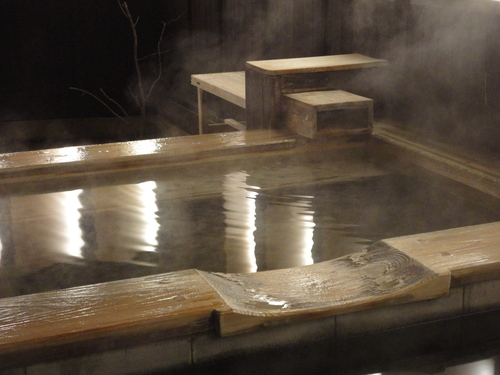
The water also has a high concentration of sodium chloride (4g/kg), which promotes circulation and keeps your body feeling warm for several hours. In other words, the water is good for the health and for beautiful skin.

There is an indoor bath made of stone and several outdoor cedar baths. In winter, it's best to warm up in the indoor bath first. One of the outdoor baths is only lukewarm but the water is full of fine bubbles, like carbonated water, which are especially good for the skin.


The bath is also very reasonably priced: only 600 yen/person (300 yen for children 3 years and older) compared to some of the super spas.
How to use the bath:
Take your shoes off and put them in the lockers.


Buy tickets (600 yen/adult, 300 yen/child 3 years to 12 years) from a vending machine beside the shoe lockers and give the ticket to the person at the counter. Bring your own towel, soap and etc. If you forget something, they sell pretty much everything you would need, including T-shirts.

Men's and women's baths are separate and are distinguished by blue writing (for men) and red writing (for women) on the curtain over the entrance to the changing rooms. Take off your clothes in the changing room and put your belongings in a locker.

Before getting into the bath, wash your body at one of the showers that line the side of the room. Enter the communal tubs once you are clean and enjoy a nice long soak.

You can relax on the tatami mats in the lobby after the bath and enjoy a snack or meal at the restaurant.
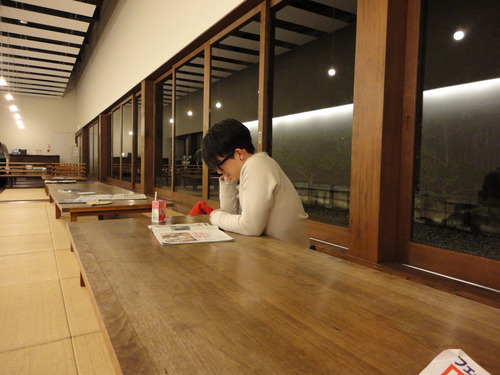


Hours: 11:00-24:00 (9:00-24:00 on weekends and holidays)
Closed: every 4th Tuesday
Access:
It's about a 10 minute walk from Busshozan station on the Kotoden line.
Address: 114-5 Ko Busshozan-cho, Takamatsu, Kagawa
Website: http://busshozan.com/ Go to the bottom of this site for a map (Japanese only).
Busshozan Hot Spring at night
Busshozan hot spring was discovered when scientists were investigating an underground crater 4 km in diameter and 2 km deep that lies beneath this area. They believe it might have been formed thousands of years ago by a meteor strike. The bath opened in 2005 and the design is very sleek and simple, a nice combination of modern architecture and Japanese tradition.
More than the design, however, it's the quality of the water that keeps our whole family going back. It has a slippery feel caused by a high concentration of sodium bicarbonate (7g/kg) and it leaves your skin feeling smooth and silky for days afterwards. Be careful not to slip in the bathtub, though!
The water also has a high concentration of sodium chloride (4g/kg), which promotes circulation and keeps your body feeling warm for several hours. In other words, the water is good for the health and for beautiful skin.
There is an indoor bath made of stone and several outdoor cedar baths. In winter, it's best to warm up in the indoor bath first. One of the outdoor baths is only lukewarm but the water is full of fine bubbles, like carbonated water, which are especially good for the skin.
The bath is also very reasonably priced: only 600 yen/person (300 yen for children 3 years and older) compared to some of the super spas.
How to use the bath:
Take your shoes off and put them in the lockers.
Buy tickets (600 yen/adult, 300 yen/child 3 years to 12 years) from a vending machine beside the shoe lockers and give the ticket to the person at the counter. Bring your own towel, soap and etc. If you forget something, they sell pretty much everything you would need, including T-shirts.
Men's and women's baths are separate and are distinguished by blue writing (for men) and red writing (for women) on the curtain over the entrance to the changing rooms. Take off your clothes in the changing room and put your belongings in a locker.
Before getting into the bath, wash your body at one of the showers that line the side of the room. Enter the communal tubs once you are clean and enjoy a nice long soak.
You can relax on the tatami mats in the lobby after the bath and enjoy a snack or meal at the restaurant.
Hours: 11:00-24:00 (9:00-24:00 on weekends and holidays)
Closed: every 4th Tuesday
Access:
It's about a 10 minute walk from Busshozan station on the Kotoden line.
Address: 114-5 Ko Busshozan-cho, Takamatsu, Kagawa
Website: http://busshozan.com/ Go to the bottom of this site for a map (Japanese only).
Posted by cathy at
08:04
│Comments(0)
2012年03月27日
Art in the Park
The other day I strolled into Takamatsu's Chuo Koen, which translates as "Central Park". I often go there when I"m downtown.
The park on a gray day in March
1
Although it's nice, it doesn't look like anything special and, of course, it can't compete with the famous park of the same name in New York. Still, it serves as a haven for many office workers and businessmen who come here to eat their lunches.

In spring and summer, it makes a great picnic site, especially with these great wading spots for the kids.
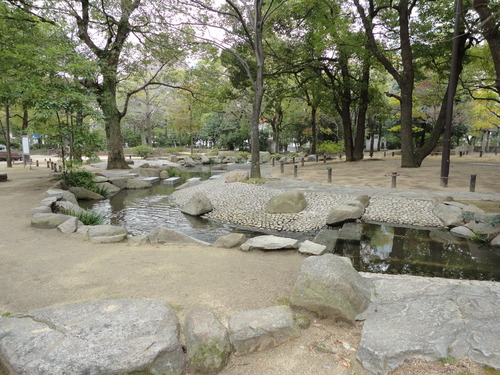


But what is really surprising is the art to be found within the grounds. With Takamatsu being the home of Aji granite and some of the best stonemasons in the country, there is a lot of great stone art.
Like this

Ofr course, not everyone sees stone as art. For some, stones are just great substitutes for sports lockers.

The park is also a treasure trove of high quality contemporary sculpture by local and semi-local artists such as...
"Sanuki" by Hayami Shiro, a work that reminds me a bit of Japanese rock gardens, where you can never see all the stones at once.
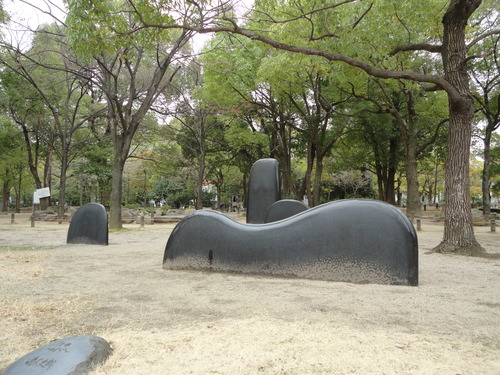
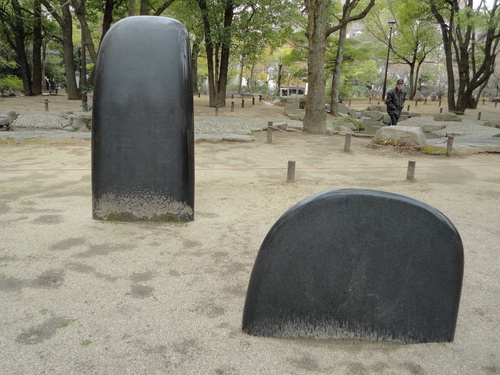
and "Well-Spring" by Yamada Masaji
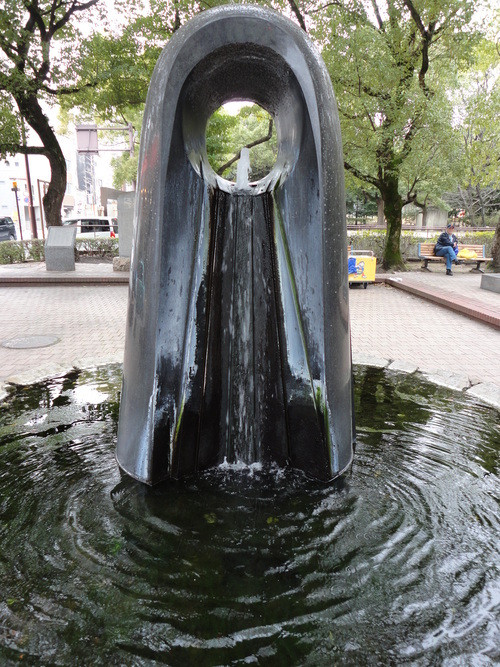


The number of works has increased over the years with the most recent additions being three pieces of Isamu Noguchi* Play Equipment, installed in 2010. What a treat to be allowed to play on art!
"Octetra"

Inside looking out
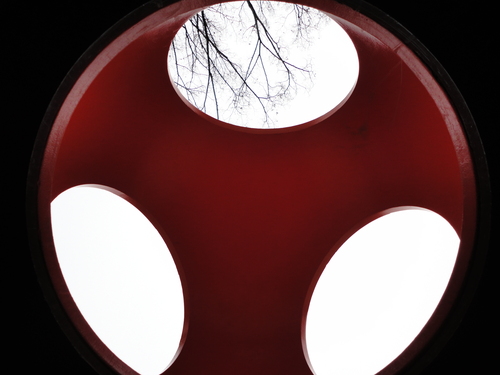


"Play Sculpture"
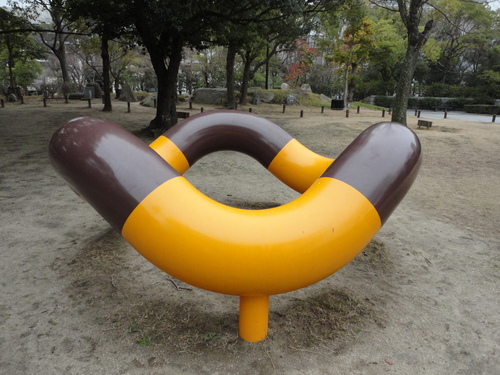
Which feels a bit like riding on the back of a serpent.
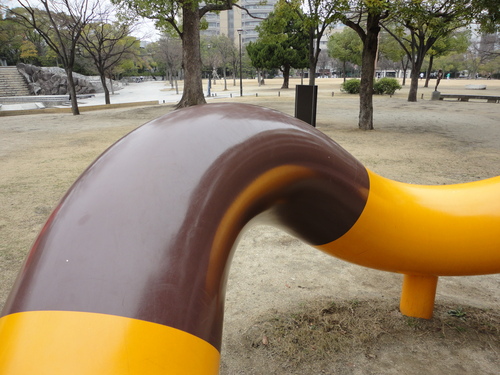
"Seesaw"

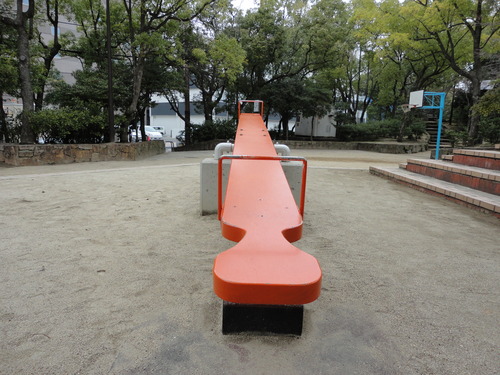
And that's just a taste of what's there to discover.
The park is actually a symbol of peace and the city's rebirth from the ashes of World War II. For centuries, the land belonged to a major temple but this, along with most of downtown Takamatsu, was burned to the ground in July 1945 when the city was firebombed. When the war ended a month later, the site was set aside for parkland. It was used as a ballpark for almost forty years. Then, in 1985, it was turned into Central Park, a place for citizens' to enjoy the fruits of their recovery efforts. It is now the site for many annual events and festivals.
* Isamu Noguchi was an outstanding 20th century sculptor of mixed Japanese-American heritage. From 1969 until his death in 1988, he spent part of every year sculpting in his studio in Mure, on the east side of Takamatsu. The studio is now a museum and definitely worth a visit! (See http://www.noguchi.org/museum/japan for details.)
The park on a gray day in March
1
Although it's nice, it doesn't look like anything special and, of course, it can't compete with the famous park of the same name in New York. Still, it serves as a haven for many office workers and businessmen who come here to eat their lunches.
In spring and summer, it makes a great picnic site, especially with these great wading spots for the kids.
But what is really surprising is the art to be found within the grounds. With Takamatsu being the home of Aji granite and some of the best stonemasons in the country, there is a lot of great stone art.
Like this
Ofr course, not everyone sees stone as art. For some, stones are just great substitutes for sports lockers.
The park is also a treasure trove of high quality contemporary sculpture by local and semi-local artists such as...
"Sanuki" by Hayami Shiro, a work that reminds me a bit of Japanese rock gardens, where you can never see all the stones at once.
and "Well-Spring" by Yamada Masaji
The number of works has increased over the years with the most recent additions being three pieces of Isamu Noguchi* Play Equipment, installed in 2010. What a treat to be allowed to play on art!
"Octetra"
Inside looking out
"Play Sculpture"
Which feels a bit like riding on the back of a serpent.
"Seesaw"
And that's just a taste of what's there to discover.
The park is actually a symbol of peace and the city's rebirth from the ashes of World War II. For centuries, the land belonged to a major temple but this, along with most of downtown Takamatsu, was burned to the ground in July 1945 when the city was firebombed. When the war ended a month later, the site was set aside for parkland. It was used as a ballpark for almost forty years. Then, in 1985, it was turned into Central Park, a place for citizens' to enjoy the fruits of their recovery efforts. It is now the site for many annual events and festivals.
* Isamu Noguchi was an outstanding 20th century sculptor of mixed Japanese-American heritage. From 1969 until his death in 1988, he spent part of every year sculpting in his studio in Mure, on the east side of Takamatsu. The studio is now a museum and definitely worth a visit! (See http://www.noguchi.org/museum/japan for details.)
Posted by cathy at
01:17
│Comments(2)
2012年03月23日
A New Tradition
St. Patrick's Day in Takamatsu

March 20, 2012 marked Takamatsu's first ever Saint Patrick's Day celebration. And it was great fun! Although there are very few natives of Ireland living in this town, this event proved that there are many friends of the Irish. A great crowd came out to celebrate.


Local resident and key organizer Shane Coughlan explained what inspired this event. "The idea was to have a way to do cultural exchange with a strong focus on the arts. We established Shikoku Irish Network Japan (INJ) to arrange events that celebrate the cultures of Ireland and Shikoku, both small islands with a distinct local voice." (For more info about INJ, see: www.inj.or.jp )
Shane showing off his shamrock

Shane sees some remarkable similarities between Shikoku and Ireland. "Both islands have around 4 million people, are primarily rural, and are traditionally understood to have four distinct provinces with their own cultural identity - Ireland is divided into Leinster, Munster, Ulster and Connacht and Shikoku is divided into Tokushima, Kochi, Kagawa and Ehime with the Awa, Tossa, Sanuki and Iyo cultures. We can learn from our shared history of hardship, emigration and social revival, and benefit from exploring our differences… We are trying to share interesting aspects of Ireland with people here, and in the long term we are also seeking to promote Shikoku culture and life to the world."
And they started by sharing Irish music! With impressive musicians from Ireland (and Carolina!)

And from Japan!



Then there was dancing! (The dancers received a special crash course, some of them only 30 minutes before the performance.)



There was a costume parade with
Leprechauns

and St. Patrick
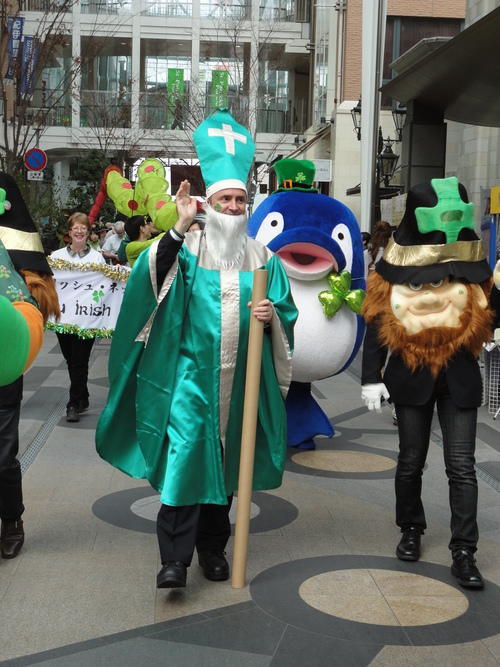
who was driving out these snakes I assume


Some local ocalina players joined in

reading music as they played.
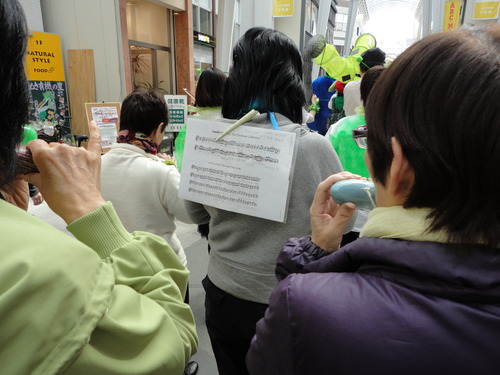
And there were many happy people sporting green....Like these boy scouts
19
and the many others who got into the spirit of things.





As I said, it was all great fun, but I'll let Shane have the last word. "...the reaction, support and enthusiasm from everyone involved - local government to local businesses to local people - was astonishing. The credit for the success of the first Irish Festival in Takamatsu belongs entirely with all those wonderful people you see in the photos."
"I would particularly like to thank Kobayashi-san at The Craic. He's genuinely mad about Irish culture and the depth of his commitment was reflected in the festival you saw." (See here for more on The Craic: www.thecraic.biz )
Kobayashi-san and family looking very happy.

Shane also tipped his hat to Michael Bedlow's "exceptional contribution...
Michael Bedlow and friends

"He is the creative whirlwind behind putting on a good show, and it seems like he has inspired many more people to think about what art, craft and traditions they might share in the future."
March 20, 2012 marked Takamatsu's first ever Saint Patrick's Day celebration. And it was great fun! Although there are very few natives of Ireland living in this town, this event proved that there are many friends of the Irish. A great crowd came out to celebrate.
Local resident and key organizer Shane Coughlan explained what inspired this event. "The idea was to have a way to do cultural exchange with a strong focus on the arts. We established Shikoku Irish Network Japan (INJ) to arrange events that celebrate the cultures of Ireland and Shikoku, both small islands with a distinct local voice." (For more info about INJ, see: www.inj.or.jp )
Shane showing off his shamrock
Shane sees some remarkable similarities between Shikoku and Ireland. "Both islands have around 4 million people, are primarily rural, and are traditionally understood to have four distinct provinces with their own cultural identity - Ireland is divided into Leinster, Munster, Ulster and Connacht and Shikoku is divided into Tokushima, Kochi, Kagawa and Ehime with the Awa, Tossa, Sanuki and Iyo cultures. We can learn from our shared history of hardship, emigration and social revival, and benefit from exploring our differences… We are trying to share interesting aspects of Ireland with people here, and in the long term we are also seeking to promote Shikoku culture and life to the world."
And they started by sharing Irish music! With impressive musicians from Ireland (and Carolina!)
And from Japan!
Then there was dancing! (The dancers received a special crash course, some of them only 30 minutes before the performance.)
There was a costume parade with
Leprechauns
and St. Patrick
who was driving out these snakes I assume
Some local ocalina players joined in
reading music as they played.
And there were many happy people sporting green....Like these boy scouts
19
and the many others who got into the spirit of things.
As I said, it was all great fun, but I'll let Shane have the last word. "...the reaction, support and enthusiasm from everyone involved - local government to local businesses to local people - was astonishing. The credit for the success of the first Irish Festival in Takamatsu belongs entirely with all those wonderful people you see in the photos."
"I would particularly like to thank Kobayashi-san at The Craic. He's genuinely mad about Irish culture and the depth of his commitment was reflected in the festival you saw." (See here for more on The Craic: www.thecraic.biz )
Kobayashi-san and family looking very happy.
Shane also tipped his hat to Michael Bedlow's "exceptional contribution...
Michael Bedlow and friends
"He is the creative whirlwind behind putting on a good show, and it seems like he has inspired many more people to think about what art, craft and traditions they might share in the future."
Posted by cathy at
15:48
│Comments(2)



